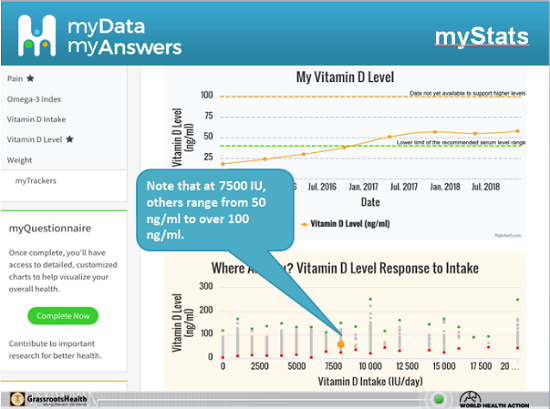Published on January 10, 2019
On occasion we have participants who experience a lower than expected vitamin D level. In this blog we will explore possible causes of a low or slow to rise vitamin D response.
1. UVB exposure
 If you’re relying more heavily on sun exposure (or indoor tanning) for vitamin D, not exposing enough skin, high sunscreen use, or lack of mid-day (10 am – 2 pm) exposure will limit vitamin D production. Environmental factors such as smog and cloud cover or residing in a higher latitude will also reduce exposure to UVB radiation. Additionally, the amount of melanin in the skin influences vitamin D production. Someone with more melanin (darker skin) might need 30 minutes in the sun to achieve the same production of vitamin D that someone with less melanin (lighter skin) will achieve in 10 minutes. While some people can achieve very high levels (~70 ng/ml) of vitamin D through sun exposure alone, others cannot achieve these levels without supplemental vitamin D.
If you’re relying more heavily on sun exposure (or indoor tanning) for vitamin D, not exposing enough skin, high sunscreen use, or lack of mid-day (10 am – 2 pm) exposure will limit vitamin D production. Environmental factors such as smog and cloud cover or residing in a higher latitude will also reduce exposure to UVB radiation. Additionally, the amount of melanin in the skin influences vitamin D production. Someone with more melanin (darker skin) might need 30 minutes in the sun to achieve the same production of vitamin D that someone with less melanin (lighter skin) will achieve in 10 minutes. While some people can achieve very high levels (~70 ng/ml) of vitamin D through sun exposure alone, others cannot achieve these levels without supplemental vitamin D.
2. Dietary intake of vitamin D
 Certain foods that have naturally occurring vitamin D (e.g. fish, meat, and eggs) or are fortified with vitamin D (e.g. milk and other dairy products, some orange juice and cereals) can impact vitamin D levels. Reduced consumption of these foods many lower vitamin D levels. Additionally, some foods contain vitamin D2 (not D3) such as mushrooms and some fortified foods (e.g. rice milk and soy milk) and while our body can use this form, it isn’t as effective as vitamin D3. Further, the amount of vitamin D available in food is rather small compared to what most people need to achieve a blood level of at least 40 ng/ml (e.g. salmon has ~450 IU/serving and fortified milk has ~120 IU/cup).
Certain foods that have naturally occurring vitamin D (e.g. fish, meat, and eggs) or are fortified with vitamin D (e.g. milk and other dairy products, some orange juice and cereals) can impact vitamin D levels. Reduced consumption of these foods many lower vitamin D levels. Additionally, some foods contain vitamin D2 (not D3) such as mushrooms and some fortified foods (e.g. rice milk and soy milk) and while our body can use this form, it isn’t as effective as vitamin D3. Further, the amount of vitamin D available in food is rather small compared to what most people need to achieve a blood level of at least 40 ng/ml (e.g. salmon has ~450 IU/serving and fortified milk has ~120 IU/cup).
3. Vitamin D co-factors and competitors
The intake of other nutrients has been shown to impact vitamin D levels. For example, a lack of key vitamin D co-factors such as magnesium, vitamin K, boron, and zinc can reduce vitamin D adsorption and production. On the other hand, a high intake of certain vitamins that compete with vitamin D, such as Vitamin A in the form of retinol or retinyl palmitate (not beta-carotene), can cause a reduction in vitamin D levels. This form of vitamin A is found in food from animal sources (especially liver) and some supplements. Also, some drugs including statins, prednisone and weight-loss drugs can block vitamin D.
4. Time of supplement intake
Since vitamin D is a fat-soluble vitamin, taking it with a meal that contains fat can increase adsorption. Also, adding a probiotic supplement can help with digestion in general and improve absorption of vitamin D.
5. Demographic characteristics
With increased age comes a reduced ability to absorb vitamin D though the skin and a reduction in the kidney’s ability to convert vitamin D to its active form. Also, smokers and those with a high BMI tend to have lower levels.
6. Medical conditions
A recent illness or injury may result in a lower vitamin D level. Also, digestive conditions such as irritable bowel disease, Crohn’s disease, leaky gut, or celiac disease can limit the absorption of vitamin D in the gut. Those with diseases of the liver (e.g. fatty liver) or pancreas, who have had their gallbladder removed, or who have had bariatric surgery bypassing the small intestine are more likely to have trouble absorbing or metabolizing vitamin D. For these individuals, an increased dosage or other vitamin D metabolites may be needed (please consult with your physician if this is the case).
If you have been consistently taking the same supplemental dose of vitamin D and experience a lower than expected vitamin D level, it’s possible that a change in diet, behavior, health, or the environment over the prior few months could have reduced your levels. Or, if you are having difficulty increasing your levels, try increasing your dose, taking it with your largest meal, and optimizing vitamin D co-factors to improve your levels.
To help you track your supplement use and nutrient levels, GrassrootsHealth has created an online tracking system called myData-myAnswers. For each specific supplement, you can track what days you take it, what time of the day, if it was with a meal, and many other details. This will help you know your true supplemental intake and what patterns of use work for you to reach and maintain optimum nutrient levels. Check it out today!








